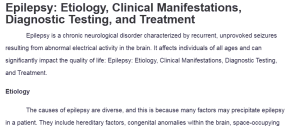Epilepsy: Etiology, Clinical Manifestations, Diagnostic Testing, and Treatment
Epilepsy is a chronic neurological disorder characterized by recurrent, unprovoked seizures resulting from abnormal electrical activity in the brain. It affects individuals of all ages and can significantly impact the quality of life: Epilepsy: Etiology, Clinical Manifestations, Diagnostic Testing, and Treatment.
Etiology
The causes of epilepsy are diverse, and this is because many factors may precipitate epilepsy in a patient. They include hereditary factors, congenital anomalies within the brain, space-occupying lesions like tumors, stroke or head injury, infectious diseases such as meningitis or encephalitis, and lastly, metabolic disorders. At other times, the underlying cause is unknown, and therefore, it is categorized as idiopathic epilepsy (National Institute of Neurological Disorders and Stroke, 2023).
Clinical Manifestations
Epileptic seizures are the hallmark manifestation and can be classified as focal or generalized. Focal seizures, also called partial seizures, occur in a particular area of the brain; the signs may be motor, sensory, or autonomic, including cramps, sensations, or gut problems. Generalized seizures affect both hemispheres and may be tonic-clonic (fainting with jerks) or absent (short loss of consciousness). Patients may also show symptoms such as pre-seizure auras in cases where seizures occur or postictal confusion shortly after seizure episodes.
Diagnostic Testing
Diagnosis depends on a careful clinical examination coupled with diagnostic tests. Electroencephalography (EEG) is the most commonly used method to diagnose pathological discharge in the cerebral structure (National Institute of Neurological Disorders and Stroke, 2023). MRI CT helps visualize structural defects that may include lesions or tumors. Other tests are blood tests to check metabolic or genetic disorders.
Treatment and Management
Treatment for epilepsy aims to control seizures and improve quality of life. Antiepileptic drugs (AEDs), such as levetiracetam and valproate, remain the cornerstone of therapy, individualized according to seizure type, age, and comorbidities. In refractory cases, interventions, including surgical interventions, vagus nerve stimulation, or dietary therapies like the ketogenic diet, might be effective. Important lifestyle changes that must be followed for general management include adequate sleep stress management and seizure precautions.
In conclusion, epilepsy is a chronic disease, meaning that a one-size-fits-all approach will not work in managing it. New developments in diagnosis and management approaches have further encouraged favorable prognosis; however, constant research and patient education are still key parts of management.
References
National Institute of Neurological Disorders and stroke. (2023). Epilepsy and seizures. Www.ninds.nih.gov. https://www.ninds.nih.gov/health-information/disorders/epilepsy-and-seizures
ORDER A PLAGIARISM-FREE PAPER HERE
We’ll write everything from scratch
Question 
Epilepsy
Discuss the etiology,clinical manifestations, diagnostic testing, and treatment/management.

Epilepsy: Etiology, Clinical Manifestations, Diagnostic Testing, and Treatment
